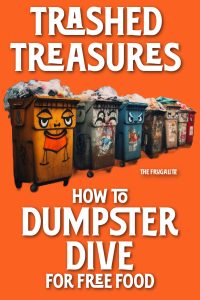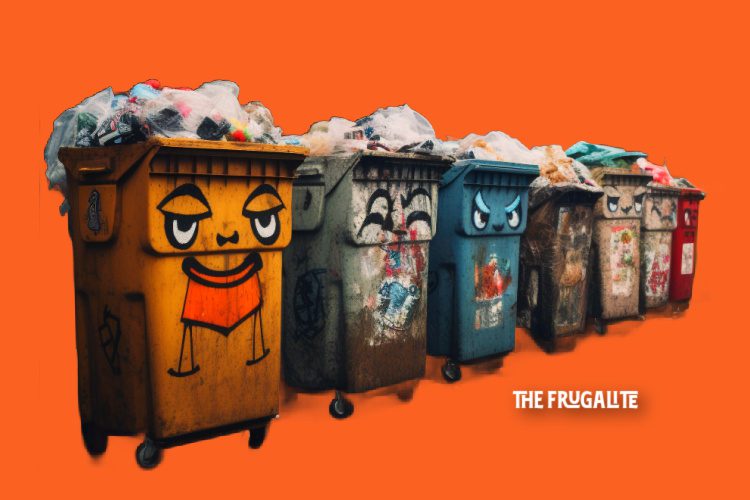(Psst: The FTC wants me to remind you that this website contains affiliate links. That means if you make a purchase from a link you click on, I might receive a small commission. This does not increase the price you’ll pay for that item nor does it decrease the awesomeness of the item. ~ Daisy)
By Lyza Hayn
Many people are put off by the prospect of doing a dumpster dive for food. Even those who regularly salvage furniture, footwear, and clothing from local bins seem iffy about actually eating from the garbage.
I am not one of those people.
I’m a big advocate for a wasteless world, especially if that means saving some major buckaroos at the grocery store. Once you realize how much free food is out there, it seems almost criminal to let it go to waste—and I’m no criminal. So, I rescue it.
Want to learn how you can dumpster dive for free food, too? Read on for a complete guide to dumpster diving for beginners, including where to start, what to bring, and how to keep your head up while you raid trash and kick ass.
1. Know where to start when you dumpster dive.
You can’t just hop in the car, drive to a random store, and expect to come away with pounds of free food. Not every dumpster will have free food. In order to strike gold, you have to think about who has the gold.
Nobody has gold in my neighborhood. Chances are, if you’re reading this, you don’t reside in the bougiest ‘burb either. That’s an issue. People who don’t have a dollar to spare tend to throw away fewer edibles, so there’s less to scavenge in poor neighborhoods.
Additionally, the more sizeable homeless population in these areas causes business owners to be more protective of their dumpsters. The solution? Go to a rich neighborhood. It’s easier to dumpster dive there, plus the stores are better. You’ll improve your chances of finding nicer edibles tenfold.
2. Choose your stores
Generally speaking, grocery stores will have the best dumpsters for those seeking food. However, I’ve found nice hauls of expired snacking foods at many places, even those that aren’t considered traditional grocers. Stores with names that rhyme with Smalgreens, Wig Wots, And Boller Beneral will toss expired packages away like nobody’s business.
Bakeries and coffee shops are also great since they throw out so many day-old bread and pastry items. Don’t discount liquor stores, either. If one can in a 24-pack of beer pops open, the pack becomes unsellable and may get tossed.
While it’s tempting to gravitate towards massive chains because of their stringent standards (and propensity to toss out perfectly good food), I always find the most favorable overall conditions at mom-and-pop stores and smaller chains. This might not be the case in your area, so it’s a good idea to check everywhere. Any place that sells food will likely throw at least some of it away.
3. Scope it out
It’s wise to drive around and scope out potential dumpsters during daylight hours. Be inconspicuous but not sneaky—you’re not doing anything illegal. At least, not yet. These stores are open during the day, and the public is allowed to traverse these areas.
While there’s no rule against walking or riding a bike through the parking lot, loitering is usually discouraged, so don’t stick around too long. Pay attention to where the dumpsters are and see if they have padlocks on them. If they do, take note—but don’t discount the place. A lot of dumpsters feature padlocks as a deterrent but never actually use them.
Determine whether the grocery stores have trash compacters, but don’t get discouraged if you see them. Compactors are very common for recycling cardboard, and sometimes there’s a row of food dumpsters just around the corner from them.
Finally, locate a quick exit. It’s pretty unlikely you’ll get in much trouble for dumpster diving, but it’s also smart to skedaddle post-haste if you get caught or the police are called.
4. Pack a go-bag
This is probably my favorite part of dumpster diving because it makes me feel like some sort of secret spy agent. But while I love playing pretend, this is serious business. Dumpster diving is dirty and can be dangerous if you go in unequipped.
As you become an expert-level food savior, you’ll be able to customize your go bag to fit your own unique needs. In the meantime, here’s a list of essentials you don’t want to skip out on:
- Headlamp: Repeat after me: we go dumpster diving at night. Or early in the morning. Not during daylight hours. A headlamp frees up your hands so you can scrounge around in the bags and see what you’re looking at.
- Gloves: Dumpsters are nasty. Bags may contain hazardous or sharp material, so take along a pair of sturdy gloves for protection.
- Knife: You’ll want a tool to rip open the garbage bags.
- Carrier bags: You need a place to store the riches you find inside the dumpster so you can take them back home.
- Sturdy box: Not everyone needs one, but some do. Dumpsters are tall; many people (like me) are short and need to climb on top of a box to reach the lid.
5. Time your forays
You want to go dumpster diving around closing time and begin your work as soon as the employees leave. There’s no need to wait since you want the freshest food possible. Try to limit interactions with anyone, even if they seem nice.
It’s not that you’re unfriendly. It’s just that you want to preserve the integrity of any spots you find. Once someone reports dumpster diving in a certain area, it’s likely store owners will begin locking the bins. If your own schedule won’t allow nighttime forays, go before the store opens in the morning. Produce won’t be as fresh, but packaged food will be fine.
6. Know what to look for when you dumpster dive

Meats, cheeses, and produce can be great scores when fresh. I’ve found pounds of pork chops and chicken breast that kept frozen for months after being salvaged. Just be sure to wash everything before you eat it and if you have a particularly amazing haul, use preservation techniques like canning to save money in the future.
Your standards are completely your own when it comes to dumpster diving. The only rule I pass on to hopeful divers is not to take anything that smells or looks like it’s actively rotting. That’s a pretty low bar, but many don’t have the luxury of setting it higher.
There’s no shame in this game.
Notable disgusting things I’ve eaten from dumpsters include an open cheese rind from the deli and a lollipop with ants all over the packaging. My best score was a wagyu strip steak, followed closely by several pounds of frozen lobster tails.
7. Get dirty
Don’t wear your Sunday best to go dumpster diving. Instead, dress discreetly in dark-colored clothes you don’t care about, grab your go bag, and get to work. You will need to climb inside the actual dumpster, sift through the bags, and open each one. It’s likely that you will have to take some bags out to reach the ones on the bottom, too.
Dumpster diving for food is way messier than sourcing other items like furniture and shoes. Grocery stores usually lump items together, so canned goods might have bits of jelly from a broken jar. However, it’s likely that certain sections of the store will be together—so once you find the “snack aisle” bag, it’s going to be pure profit.
8. Clean up
It’s tempting to hop out of the dumpster and get on your merry way once you find something good. You don’t want to stick around hanging out in a dumpster, but cleaning up after yourself is essential. You don’t want anybody to know you were there. If employees and owners see trash, they’ll implement measures to stop dumpster diving and we don’t want that.
Furthermore, leaving a mess is just rude. It reflects poorly on the whole dumpster diving community. So, put all the trash back in the dumpster and close the lid when you’re done. Only then can you scurry back to your lair to count the spoils.
Are you ready to dumpster dive into a whole new adventure?
I can’t blame you! One man’s trash is certainly another man’s treasure. Or in my case, one corporation’s trash is another woman’s treasure. Either way you bag it, dumpster diving can be a fun and creative way to live more frugally. Now that you know how to dumpster dive the smart way, get out there and get some garbage!
Did you ever dumpster dive for food? What has been your best find ever? Do you have any tips for newbies? If you haven’t, would you consider doing it?
Let’s discuss dumpster diving in the comments section!
About Lyza
Lyza Hayn is an Ozark native forest-dweller and seasoned survival kitchen whizz. Foraging is her passion and wildcrafting is her (elderberry) jam. She knows how to gather, cook, and preserve hundreds of wild edibles, tincturing and pharmacrafting dozens more. By focusing on alternative food sources and natural remedies, Lyza knows we can all live a more independent lifestyle. Her mission is to help others utilize the world around them to reduce their dependence on established systems and create a more self-reliant future.
You can check out her website at www.letteredbylyza.com or follow her on Instagram @yourmountainhome to see her point of view in photographs.











8 thoughts on “Trashed Treasures: How to DUMPSTER DIVE for Free Food”
Wig Wots!! Sometimes you’ve got to dive.
Great article-I’d like to see more by this writer!
Word of caution. Major grocery chains tend to use enclosed, locked dumpsters. This is mostly a safety precaution, so no one is caught inside when the compactor is engaged. This is why your smaller stores are probably a better bet.
A number of grocery chains donate these foods to food banks for immediate use. A truck from Second Harvest picks up food from stores all around Central Texas. Very little makes it to dumpsters.
I like this idea, however it’s going to be area dependent as the person from Texas says above. I would also suggest researching local laws to see how strict they are in your area, that is, find out how much trouble you could be in if you are caught and what kinds of things to avoid if needed. Agreed that smaller stores may well have more stuff and I would add, they likely won’t donate to places like Second Harvest.
Very informative
I’m curious to know what the thought is about cameras catching your diving? These days, many people have security cameras, door cameras, etc., and no doubt businesses would, too.
There’s a book called “The Art and Science of Dumpster Diving” by John Hoffman that addresses this very subject. The paperback version is insanely expensive now – I just checked. But it’s available on Kindle for about $10. It was independently published and the writing style is a little rough, but I found it a very entertaining read (I bought it years ago). If you have a copy of “The Tightwad Gazette,” Amy Dacyzyn also references it.